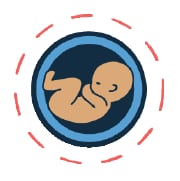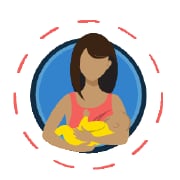Promoting Health for Infants
For infants in the first year of life, a good start begins with a healthy full-term pregnancy, a delivery without complications, a healthy and safe home environment, and good nutrition, including breastfeeding if possible. CDC works to make this healthy foundation possible for all infants.
In the United States:

1 IN 10 INFANTS
is born prematurely.

3,400 INFANTS
are lost to sudden unexpected infant death.

ONLY 26% OF INFANTS
are still being exclusively breastfed as recommended at 6 months.
CDC’s Approach

The earlier an infant is born, the more likely they are to need intensive care and a long hospital stay, with higher medical costs. Premature infants are also more likely to have lifelong health problems, like cerebral palsy, developmental delays, chronic lung disease, and vision problems.
About 1 in 10 infants is born prematurely in the United States. The rate of preterm birth among Black women is about 50% higher than that of White women, and infant death rates related to preterm birth are about twice as high for Black infants than for White infants.
Preventing and Managing Chronic Conditions
Some chronic conditions, such as high blood pressure and diabetes, increase the risk of preterm birth, and these conditions are increasing among US women of reproductive age. CDC’s National Center for Chronic Disease Prevention and Health Promotion works to prevent and control these conditions among women of reproductive age through its nutrition, physical activity, and obesity programs; its diabetes program; and its heart disease and stroke program. A key part of this work is the effort to reduce health disparities, which are differences in health across different geographic, racial, ethnic, and socioeconomic groups.
Helping Women Who Smoke Quit
About 5% to 8% of preterm births in the United States, and 5% to 7% of preterm-related deaths, are due to smoking during pregnancy. In addition, 1 in 5 babies born to mothers who smoke during pregnancy has low birth weight. CDC’s partners and grantees focus on using proven interventions to reduce smoking among women of reproductive age. Examples include increases in tobacco prices, comprehensive smokefree laws, hard-hitting media campaigns, and free help with quitting.
CDC’s Tips From Former Smokers® (Tips®) campaign, the first federal tobacco education campaign, focuses on encouraging adults who smoke to try to quit. Tips features real people living with serious long-term health effects from smoking and secondhand smoke exposure. The campaign connects people who smoke with free resources to help them quit, including resources for pregnant women or those planning to have a baby. One ad features a woman named Amanda, whose baby was born 2 months prematurely after Amanda smoked during her pregnancy.
Reducing Women’s Exposure to Secondhand Smoke
Women who are exposed to secondhand smoke during pregnancy are more likely to have lower birth weight babies. Smokefree laws for all workplaces and public areas are the only way to fully protect people who don’t smoke. They also can help people who smoke quit, and can help keep young people from starting to smoke. Comprehensive smokefree laws have been associated with reducing preterm birth for Black women and reducing the gap in preterm birth between Black and White women.
Improving Medical Care
Some women—for example, those who have had a previous preterm birth—are at higher risk of another preterm birth and can benefit from medical intervention. CDC works with health care systems to improve medical care for pregnant women and infants through Perinatal Quality Collaboratives (PQCs) in states.
Promoting Single Embryo Transfer in Assisted Reproductive Technology
Assisted reproductive technology (ART) helps many couples overcome problems with getting pregnant. However, women who conceive through ART are at higher risk of preterm birth and delivering low birth weight infants, mainly because they have a greater chance of becoming pregnant with two or more infants at a time. For eligible patients, the practice of single embryo transfer reduces this risk.
Preventing Teen and Unintended Pregnancy
Preterm births are more common for teens and for women whose births are spaced too close together. To help women prevent pregnancy until they are ready, CDC:
- Publishes clinical guidelines on contraceptive use and family planning services.
- Provides partners with strong evidence to support interventions that improve access to the full range of contraception, including long-acting reversible contraception, such as implants and intrauterine devices (IUDs).
- Provides tools for health centers to offer youth-friendly contraceptive and reproductive health services.
Supports initiatives to reduce teen pregnancy and improve the quality of adolescent and young adult sexual and reproductive health services.
Supporting Breastfeeding in the Hospital and Community
Breastfeeding is the best method for early infant feeding and the healthiest option for most mothers and infants. Infants who are breastfed have reduced risks of ear and respiratory infections, asthma, sudden infant death syndrome (SIDS), and obesity. In the United States, 84% of infants start out being breastfed, but only 1 in 4 infants is exclusively breastfed by the time they are 6 months old. Feeding infants only breastmilk for their first 6 months is recommended by the Dietary Guidelines for Americanspdf iconexternal icon and the American Academy of Pediatricsexternal icon.

Maternity care practices in the first hours and days after birth often make the difference in whether and how long infants are breastfed. CDC works with partners to help hospitals nationwide improve maternity care practices that support breastfeeding.
About every 2 years, CDC invites all hospitals across the country to fill out the Maternity Practices in Infant Nutrition and Care (mPINC) survey. The questions focus on specific parts of hospital maternity care that affect how babies are fed. CDC provides feedback to hospitals so they can improve care in these areas. The Breastfeeding Report Card also tracks national progress by compiling data on breastfeeding practices and supports in all states, the District of Columbia, Puerto Rico, Guam, and the US Virgin Islands. These efforts help mothers who want to breastfeed get the support they need while in the hospital and once they return home.
CDC also promotes breastfeeding support for mothers and infants in worksites, childcare settings, and communities.
Promoting the Introduction of Healthy Foods and Drinks
Early feeding practices are important for the healthy growth of infants. The Dietary Guidelines for Americans and the American Academy of Pediatrics recommend children be introduced to foods other than breast milk or infant formula when they are about 6 months old.
Starting good nutrition practices early can help children develop healthy dietary patterns. CDC offers information and practical strategies on feeding healthy foods and drinks to infants and toddlers.
Many infants spend time in care outside of their home, making Early Care and Education (ECE) facilities an important place to encourage healthy eating and build a foundation for healthy habits. Such facilities include childcare centers as well as large and small family care homes. CDC is working with national organizations, states, communities and other key ECE partners to help childcare providers adopt nutrition best practices and encourage family involvement in ECE settings.
Health care providers are also key partners in helping caregivers establish healthy eating practices. CDC has supported the American Academy of Pediatrics to develop a suite of toolsexternal icon for providers and caregivers on early child nutrition.

Two of the most important ways that parents can make their homes healthy and safe for their infant are to make sure no one smokes in the home and that the infant has a safe sleep environment.
Monitoring Sleep-Related Infant Deaths
Sleep-related infant deaths include SIDS, accidental suffocation and strangulation in bed, and deaths from other unknown causes. About 3,400 infants died from sleep-related causes in the United States in 2019. Most deaths occurred while the infant was sleeping in an unsafe environment. To keep infants safe while sleeping (at night and during naps), parents and caregivers should:
- Place infants on their back at all sleep times, including naps and nighttime.
- Not allow infants to share their bed.
- Use a firm surface, such as a mattress in a safety-approved cribexternal icon, covered by a fitted sheet.
- Remove all soft objects, such as pillows or loose bedding, in the sleep area.
Different practices in investigating and reporting sleep-related infant deaths can affect the ability to reliably monitor trends and risk factors at the state and national level. In addition, because parents or caregivers do not usually see these deaths as they happen, investigators may not be able to get a clear description of the circumstances surrounding the death, which is necessary for determining the cause.
CDC supports sudden unexpected infant death (SUID) surveillance programs in 22 areas of the country. This tracking effort, which covers 30% of all cases, leads to a better understanding of the events surrounding sleep-related infant deaths. It is designed to improve the quality of information collected at infant death investigations. Participants in CDC’s SUID and Sudden Death in the Young (SDY) Case Registry use data about trends and circumstances to better understand these deaths and reduce future deaths.
Preventing Secondhand Smoke Exposure
Infants can be exposed to secondhand smoke in vehicles and homes, especially if they live in multi-unit housing—like apartment buildings with many homes next to one another in the same place.
Babies exposed to secondhand smoke are more likely to die from SIDS. Babies exposed to secondhand smoke in the womb or after birth are born and grow up with weaker lungs than babies who are not exposed to secondhand smoke. Babies and children who are exposed to secondhand smoke are sick more often with bronchitis, pneumonia, and ear infections than those who are not exposed to secondhand smoke.
In FY 2021, CDC provided over $96 million to 50 states and the District of Columbia, 8 territories and freely associated states, 26 tribes, 8 national networks, and several other partners to support their work in reducing disease and death from commercial* tobacco products.
The goals of these programs are to:
- Prevent young people from using tobacco products.
- Help people quit using tobacco products.
- Eliminate exposure to secondhand smoke.
- Advance health equity by identifying and eliminating tobacco-related disparities.
* When CDC references tobacco on this web page, we are referring to the use of commercial tobacco and not the sacred and traditional use of tobacco by some American Indian communities.
Oral health is essential to general health and well-being across the lifespan, and good oral health starts during infancy. Parents and caregivers should:
- Wipe gums twice a day with a soft, clean cloth in the morning after the first feeding and right before bed. This helps wipe away bacteria and sugars that cause cavities.
- When teeth come in, start brushing twice a day with a soft, small-bristled toothbrush and plain water.
- Visit the dentist by your baby’s first birthday to spot signs of problems early.
- Talk to your dentist or doctor about putting fluoride varnish on your baby’s teeth as soon as the first tooth appears.
CDC is committed to improving awareness among health care professionals and families about the importance of oral health during pregnancy and infancy. In 2019, CDC launched the Protect Tiny Teethexternal icon initiative in collaboration with the American Academy of Pediatrics (AAP). This initiative includes resources for clinicians to engage with their pregnant patients about their oral healthcare needs, as well as resources for pregnant and new moms to promote good oral health during pregnancy and infancy. All materials are available in English and Spanish, and the patient materials are also available in Arabic, Cambodian, French, Korean, Russian, Taiwanese, and Vietnamese.
